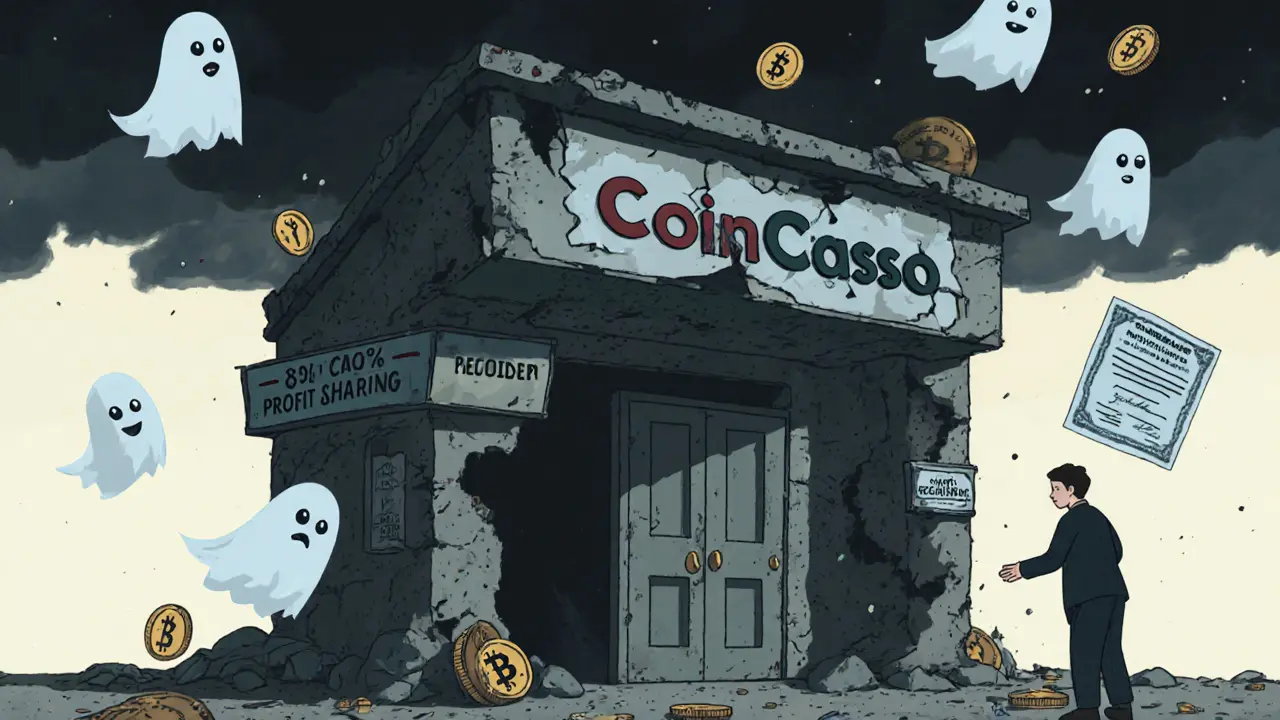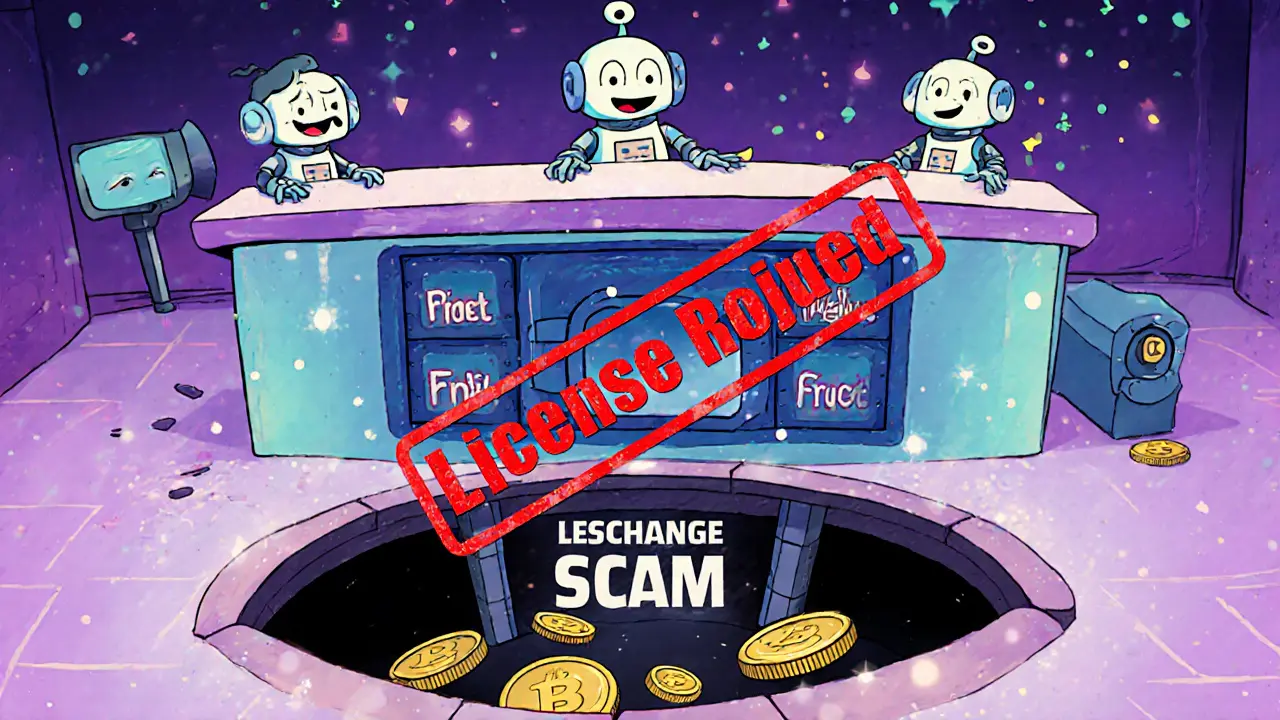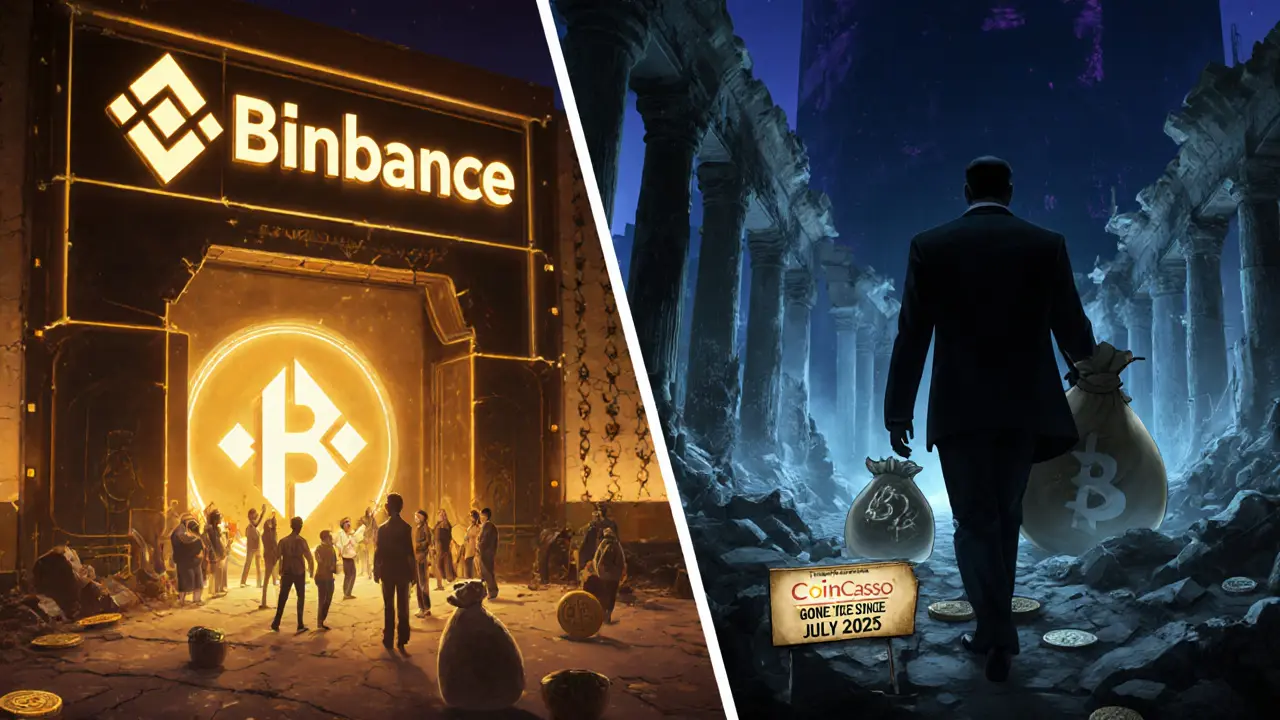 Nov, 11 2025
Nov, 11 2025
Crypto Exchange Safety Checker
This tool checks if a cryptocurrency exchange meets basic safety criteria based on red flags identified in the CoinCasso scam case. Enter details about an exchange to see if it passes the minimum safety standards.
If you're looking at CoinCasso as a place to trade crypto, stop. Right now. This isn't a case of "it's not the best" - this is a case of "it never should have existed." By July 2025, CoinCasso was officially dead. No trading. No customer support. No refunds. Just silence. And the warning signs were there for years.
What CoinCasso Claimed to Be
CoinCasso tried to look like a normal crypto exchange. It said it was based in Estonia. It held two licenses: one for virtual currency wallets (FRK000282) and another for exchanging crypto to euros and Polish zlotys (FVR000340). It offered trading pairs with USDT, ETH, and BTC. You could deposit via bank transfer, debit card, or crypto. Minimum deposit? As low as 1 PLN or 20 EUR. The interface used TradingView, so it looked professional. It even claimed to have mobile apps on iOS and Android. It promised something no other small exchange did: up to 80% profit sharing. That’s not a bonus. That’s not a referral program. That’s a promise to give you most of the exchange’s profits - a red flag wrapped in a shiny bow. And it offered a crypto debit card, which sounded like a real perk. But none of that mattered because the numbers didn’t add up.The Numbers That Exposed the Lie
In December 2021, CoinCasso recorded just $107,613 in 24-hour trading volume. That’s less than the daily volume of a single popular meme coin on Binance. For comparison, Binance was doing over $50 billion a day at the time. CoinCasso’s volume was 0.0002% of that. Low volume means one thing: you couldn’t trade without moving the price. Want to sell 10 ETH? Good luck finding a buyer. The order book was empty. The platform was a ghost town. Even worse, the licenses it claimed to have were revoked. Estonia cracked down hard on crypto exchanges between 2021 and 2022. Hundreds of licenses were pulled for failing compliance checks. CoinCasso vanished from public records. It didn’t just fade away - it was erased. The Estonian authorities didn’t shut it down quietly. They removed it from the registry. That’s not a suspension. That’s a death certificate.Scam Patterns That Match Perfectly
Multiple trusted sources now list CoinCasso as a scam. BTCC.com warns: "Contacting CoinCasso customer service is part of the scam." That’s not a rumor. That’s a direct warning from a platform that tracks crypto fraud. Here’s how it worked: users deposited funds. They traded a little. Everything looked fine. Then they tried to withdraw. Suddenly, support asked for more fees. More KYC documents. More "verification payments." Each time, the user paid. And each time, the withdrawal got delayed. Eventually, the emails stopped replying. The website went dark. The apps disappeared from app stores. And the money? Gone. Forex Peace Army, a site that tracks fraudulent financial services, marked CoinCasso as "Out of business" in July 2025. Cryptolegal.uk put it on their 2025 list of "fake crypto exchanges." TradersUnion.com called it "a fraudulent cryptocurrency exchange registered in Lithuania" - a country it never officially operated from. Even the profit-sharing claim? A trap. No legitimate exchange shares 80% of profits. That’s how Ponzi schemes lure people in. You think you’re making money from trading. You’re actually funding new deposits.
What Users Actually Experienced
A few users left positive reviews on Forex Peace Army, calling it the "best crypto exchange with Euro and SEPA." But those reviews look suspicious. Why? Because they were isolated. There were no consistent positive patterns. No detailed walkthroughs. No long-term success stories. Just one or two glowing reviews in a sea of silence. PartnerKin.com collected three user reviews. One said the interface was clean but fees were "above average." Another said customer support was "responsive, especially to newer users." That’s the classic scam pattern: treat new users well until they deposit. Then, when they try to withdraw, support vanishes. The responsive team? Likely bots or low-paid staff hired just to keep people calm while their funds were siphoned off. The trading fees were 0.125% to 0.25% - not terrible on paper. But when your liquidity is so low, the real cost isn’t the fee. It’s the slippage. You want to buy 1 BTC at $60,000. You place a limit order. No one’s selling. You raise your price to $60,500. Still no takers. You finally buy at $61,200. That’s a 2% loss before you even move the price. CoinCasso’s fees were the least of your problems.Why It Failed - And Why You Should Avoid Anything Like It
CoinCasso entered the market in 2019 when crypto regulation was still loose. It targeted Eastern European users with EUR and PLN pairs - smart move. But it never built real infrastructure. No cold storage. No insurance. No audit reports. No transparency. Just a TradingView frontend and a promise of profit sharing. Compare that to Binance, Coinbase, or even smaller but legit platforms like Gate.io. They have multi-sig wallets. They publish proof-of-reserves. They’re regulated in multiple jurisdictions. They have real customer support teams with track records. CoinCasso had none of that. The real lesson here isn’t about CoinCasso. It’s about how to spot a fake exchange before you lose money:- Check trading volume. If it’s under $1 million daily, avoid it unless you know why.
- Verify licenses. Go to the regulator’s official site. Don’t trust what the exchange says.
- Look for withdrawal complaints. Search "[exchange name] + withdrawal + scam" on Reddit or Trustpilot.
- Ignore profit-sharing promises. No exchange shares 80% of profits. That’s a Ponzi.
- Check if it’s listed on Exchange Graveyard. Cryptowisser’s graveyard is a free, reliable tool.

What to Use Instead
If you need a crypto exchange that works, here are real alternatives:- Gate.io - Best overall alternative. Good liquidity, low fees, supports fiat deposits.
- Zengo Wallet - Non-custodial, no KYC, built-in security. Great for beginners.
- Binance - Highest liquidity, 500+ trading pairs, 24/7 support.
- Coinbase Exchange - Regulated in the US and EU. Safe for new users.
- UPHOLD - Supports crypto and fiat in one account. Good for EUR/USD traders.
Final Warning
CoinCasso is gone. The money is gone. The licenses are revoked. The websites are offline. The apps are uninstalled. If someone tells you they’re "reopening" CoinCasso or "recovering funds," they’re running the same scam - just with a new name. Don’t fall for the nostalgia. Don’t trust the old reviews. Don’t believe the "I made money once" stories. The only thing that matters now is: avoid CoinCasso completely. It’s not risky. It’s not questionable. It’s a confirmed scam.If you used CoinCasso and lost money, don’t contact their "support." Don’t pay any "recovery fee." Report it to your local financial authority. And move on. There are hundreds of legitimate exchanges waiting for you.
Is CoinCasso still operating in 2025?
No. CoinCasso is officially dead. Cryptowisser marked it as "dead" in their Exchange Graveyard, and Forex Peace Army listed it as "Out of business" with a July 24, 2025 update. The platform no longer accepts deposits, withdrawals, or trades. Any website or app claiming to be CoinCasso is a clone or scam.
Was CoinCasso regulated?
CoinCasso claimed to hold two Estonian licenses (FRK000282 and FVR000340), but both were revoked by the Estonian Financial Intelligence Unit during the 2021-2022 crackdown on uncompliant crypto firms. The exchange was not properly regulated at the time of its shutdown. Its license numbers are no longer active in official public registries.
Can I recover my money from CoinCasso?
There is no legitimate way to recover funds from CoinCasso. Any service claiming to help you get your crypto back is a secondary scam - often called a "recovery scam." They’ll ask for an upfront fee, then disappear. The original exchange has no assets, no staff, and no infrastructure left. Your best option is to report the loss to your bank or financial regulator and move on.
Why did CoinCasso shut down?
CoinCasso shut down because it was an exit scam. It attracted users with low minimum deposits, fake profit-sharing promises, and a professional-looking interface. Once enough funds were deposited, the operators disappeared. Its extremely low trading volume ($107k/day in 2021) meant it couldn’t sustain operations legitimately. Combined with revoked licenses and regulatory pressure, it collapsed under its own fraud.
Is CoinCasso listed as a scam by official agencies?
Yes. Multiple authoritative sources classify CoinCasso as a scam: Cryptolegal.uk includes it in their 2025 list of reported scam companies. BTCC.com warns users that customer service interactions are part of the fraud. TradersUnion.com explicitly labels it a fraudulent exchange. These are not user opinions - they’re based on regulatory data and forensic analysis of platform behavior.
What should I look for in a safe crypto exchange?
Look for: high trading volume (over $100M daily), published proof-of-reserves, clear regulatory status (e.g., licensed in EU, US, or UK), cold storage for funds, two-factor authentication, and a long track record. Avoid exchanges that promise profit-sharing, have no public team, or don’t list their licensing details on official regulator websites.
Arthur Crone
November 11, 2025 AT 10:4980% profit sharing? Bro that's not a business model it's a neon sign saying "I'm a Ponzi". The fact people fell for this is embarrassing. Low volume + revoked licenses + no audits = textbook exit scam. Stop wasting time on these ghost platforms.
Just use Binance or Coinbase. Everything else is gambling with your life savings.